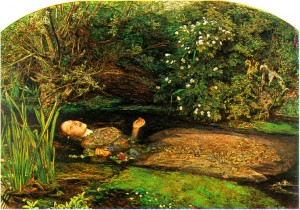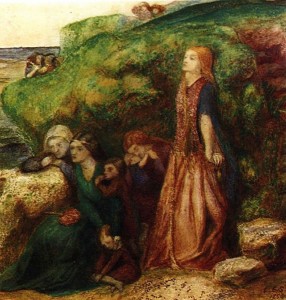When you think of “Pre-Raphaelite”, what comes to mind? For me, it is male painters, female subjects, a lot of nature, and vivid colours. And for 95% percent of paintings produced by this movement, this is the reality.
The key members of the group (Hunt, Millais, the two Rossettis, Collinson, Stephens, and Woolner) were all men. Together, they created a secret group called the Pre-Raphaelite Brotherhood. Like just about every other artistic movement, the Brotherhood wanted reform. They rejected the academic styles of Raphael and artists after him, finding them idealised and corrupted. The Brotherhood sought a return to the Pre-Raphael Italian style with its vivid colours and imitation of nature.

Sir John Everett Millais, Ophelia, 1851-1852. Oil on canvas, 76.2 cm × 111.8 cm. Tate Britain, London.
The Pre-Raphaelites insisted on painting nature from direct observation to ensure it was depicted with accuracy and detail. Millais even stood outside for four months painting the background of one of the most well-known paintings of the movement, Ophelia (above). After he painted the landscape, he had the model for Ophelia lie in a full bathtub in his studio. But who was this model whose face is now so well-known? Her name was Elizabeth Siddal, and she eventually became a Pre-Raphaelite artist as well, which brings us to the exceptions to the 95% rule I mentioned earlier: the female artists who successfully joined the “brotherhood.”
Elizabeth Siddal was one of several model-turned-artists of the Pre-Raphaelite movement. She was a model for almost all of the members of the Brotherhood, and was the primary subject of Rossetti (who was said to have painted Siddal thousands of times). It’s no surprise that Rossetti and Siddal became lovers and eventually married. Rossetti taught Siddal to paint; she caught on quickly and developed her own unique style. Her self-portraits (see below) are interesting because one can compare how she perceived herself as opposed to how she was perceived by the artists she modelled for. Her other paintings (such as The Ladies’ Lament, below) are characteristic of the Pre-Raphaelite movement, with their focus on nature, vivid colours, and realistic subjects.

Elizabeth Siddal, The Ladies’ Lament, 1856. Watercolour on paper, 241 x 229 mm. Tate Britain, London.
Siddal was not the only female Pre-Raphaelite artist. Another notable woman from the movement was Rosa Brett, who was taught to paint by her brother, John Brett, and focused on painting landscapes. In fact, there are at least twenty others. Several of them, including the celebrated Jane Burden Morris, were also models-turned-lovers-turned-artists like Siddal.
Although these 19th century women did not have access to their own formal art education, they found other ways to learn. Luckily for them, the Brotherhood was actually quite forward-thinking in their attitude towards female painters, who they welcomed into their circle. Despite the implied gender in the name, the Pre-Raphaelite Brotherhood was a movement that enabled women to pursue their passions and do more than just pose for paintings. Women were finally beginning to establish themselves in the artistic world.
If you are in London before January 13, 2013, make sure to check out the exhibition on the Pre-Raphaelites at the Tate Britain. You may be distracted by the amazing paintings by the Brotherhood, but keep your eye out for the 5%—the ones done by the women. If you can’t make it to the exhibition or just want to learn more about this movement, check out our ebook.
By Category
Recent News
- 04/03/2018 - Alles, was du dir vorstellen kannst, ist real
- 04/03/2018 - Tout ce qui peut être imaginé est réel
- 04/03/2018 - Everything you can imagine is real
- 04/02/2018 - Als deutsche Soldaten in mein Atelier kamen und mir meine Bilder von Guernica ansahen, fragten sie: ‘Hast du das gemacht?’. Und ich würde sagen: ‘Nein, hast du’.
- 04/02/2018 - Quand les soldats allemands venaient dans mon studio et regardaient mes photos de Guernica, ils me demandaient: ‘As-tu fait ça?’. Et je dirais: “Non, vous l’avez fait.”

